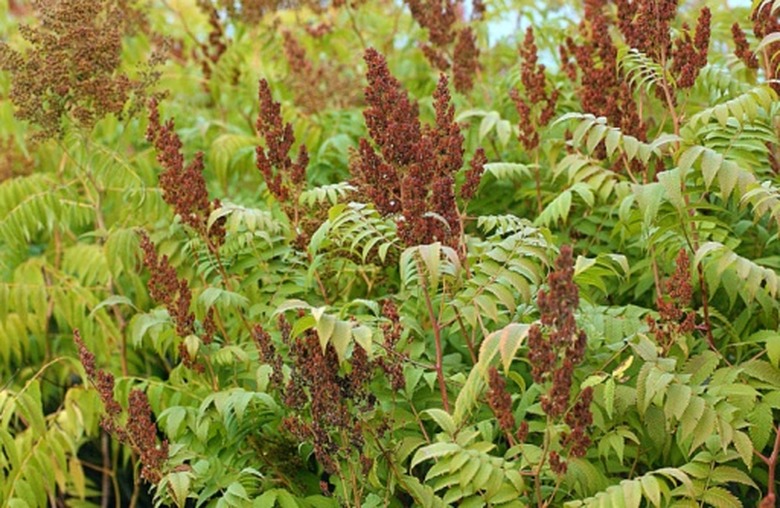Types Of Sumac Trees
Sumac trees belong to the Anacardiaceae plant family and occur naturally in temperate and subtropical climates. Most sumac trees have ornamental features that make them an attractive addition to landscapes. Choose sumac trees according to the tree's mature size, bloom time, flower color, potential usage and your USDA hardiness zone.
Chinese Sumac
Chinese sumac (Rhus chinensis) comes from Japan and China and generally winters well in USDA hardiness zones 5 to 8. Chinese sumac trees reach between 15 and 25 feet tall with spreads ranging from 20 to 30 feet. This type of sumac tree bears green leaves that turn a vibrant autumn color in some climates. Panicles of cream to white blossoms appear in August and September, followed by clusters of hairy, red fruit. Chinese sumac tolerates various soil conditions as long as it has good drainage. This tree prefers full sun to partially shady locations. Blisters, cankers and rusts sometimes occur. Plant Chinese sumac trees in open woodlands or woodland margins.
- Sumac trees belong to the Anacardiaceae plant family and occur naturally in temperate and subtropical climates.
Winged Sumac
The winged sumac (Rhus copallina)–also called the flameleaf sumac–is a small tree that ranges from 15 to 30 feet high with spreads up to 20 feet. This United States native winters well in hardiness zones 4 to 9. Winged sumac trees prefer well-drained soils in partially shady to fully sunny locations. The green leaves turn flaming red in the fall. Small, green-yellow flower panicles bloom in July and August, followed by maroon to brown fruits. Watch for mites, scale and leaf spots. Use winged sumac in naturalized areas or open woodlands.
- The winged sumac (Rhus copallina)–also called the flameleaf sumac–is a small tree that ranges from 15 to 30 feet high with spreads up to 20 feet.
- Winged sumac trees prefer well-drained soils in partially shady to fully sunny locations.
Staghorn Sumac
Staghorn sumac (Rhus typhina) earned its name because of the red-brown hairs that coat the branches, much like the red-brown velvet that covers a male deer's horns. The large, green leaves turn attractive reds, oranges and yellows in the fall. Small, green-yellow blossoms appear in June and July, followed by clusters of bright red to deep red fruit. Caterpillars, cankers and rusts might appear. This type of sumac tree prefers well-drained soils in partial shade to full sun. This U.S. native generally winters well in hardiness zones 3 to 8. Staghorn sumac trees range from 15 to 25 feet in height and 20 to 30 feet in width. Plant staghorn sumac trees in the margins of swamps, streams or woodlands.
- Staghorn sumac (Rhus typhina) earned its name because of the red-brown hairs that coat the branches, much like the red-brown velvet that covers a male deer's horns.
- The large, green leaves turn attractive reds, oranges and yellows in the fall.
Evergreen Sumac
The evergreen sumac (Rhus virens)–also called the tobacco sumac–can be trained into a small tree ranging from 8 to 12 feet tall with spreads up to 10 feet. The leathery, green leaves have a pink tint when young and a maroon tint after the first frost. Non-showy, greenish-white or yellow flowers appear in July and August, giving way to orange-red, hairy fruit in September. Evergreen sumacs can handle various, well-drained soils in partially shady to fully sunny locations, but are more likely to reach tree size when planted in the shade. Winter hardy to USDA zone 8, the evergreen sumac performs well as an erosion control tree on banks, slopes and rocky hills.
